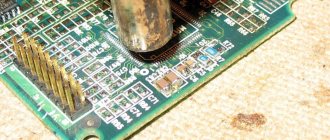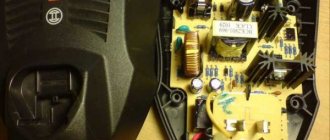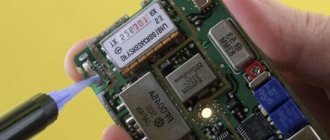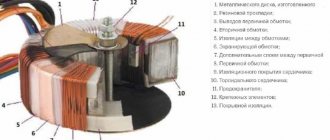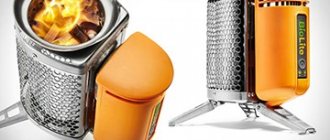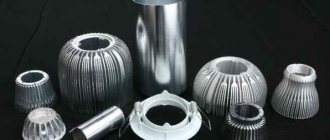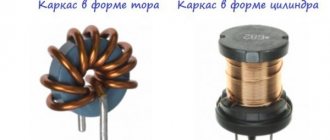Varieties of stings
All modern sets of tips for soldering irons differ significantly from each other, it all depends on the material, protective coating, shape and thickness. In addition, each replacement tool can dissipate different amounts of power, which is very important when choosing the most suitable product. Experts say that the most important thing to consider is what material the tip is made of and what shape it has.
As for the material, depending on the tasks, you can use tips with copper, ceramic, copper-steel, brass, chrome or nickel coating. The shape of the product can also differ significantly: curved, pointed, cone-shaped and even with a cut. As practice shows, it is easiest to use a curved device to remove excess solder, as well as to dismantle parts from the board. It is the material and shape of the tips that play an important role in the operation of the soldering iron, since the following characteristics depend on them:
- The resulting ability to inject energy at the soldering site. It is this characteristic that determines the possibility of high-quality and uniform heating of the working area.
- The level of thermal conductivity, which determines the final amount of heat supplied from the soldering tool to the working area.
- The degree of resistance of the tip used to oxidation.
A high-quality soldering iron with a replaceable tip must be equipped with a tip made of copper and special alloys. This criterion is due to the fact that the final thermal conductivity of the removable product will be significantly higher than that of steel parts.
But, despite all the advantages, even copper tips have their drawbacks. The main part of them is associated with the low level of wear resistance of the material and the fact that they are susceptible to the negative effects of corrosion. To eliminate these nuances, manufacturers apply a nickel or steel coating to the tip, and the thermal conductivity of the tip changes.
Due to the fact that gas soldering irons are widely in demand both in the private and industrial spheres, manufacturers produce a wide range of tips with different performance characteristics. Thanks to this, you can purchase the most suitable soldering iron rod at an affordable price.
Modern soldering irons are already soldering stations
What is a soldering station? This is not necessarily a soldering iron + soldering iron set. It can be one soldering iron, but with regulation, configuration, control and temperature indication. Modern soldering irons can fit all this right into the handle. Therefore, such soldering irons can be considered stations. But due to the more familiar format “just a soldering iron and a power cord from it”, it is still perceived as an ordinary soldering iron, and not a station.
A soldering station doesn't have to be expensive. It may even be cheaper than some soldering irons. Further in the article there will be examples of such conventional “soldering stations”.
As modern electronics installation has become more complex, the need for different types of tips and temperature control has increased.
Main advantages
Universal soldering iron tips are distinguished by their versatility and high quality, which is very important for repair work. The great demand for working tips is due to their many advantages:
- The ability to accumulate generated thermal energy. It is worth considering that this factor largely depends on the size of the part. Experts say that a soldering iron with a thin tip gives off all the heat at the first contact with the metal.
- High degree of thermal conductivity. This is one of the most important characteristics. This criterion determines how much heat from heating will be transferred to the main work area.
- Oxidation resistance. The presence of even the thinnest film of oxides several times reduces the ability of the tip to transfer heat to the soldering site.
- Good wear resistance. Of course, no one will use a soldering iron to perform tasks that are unusual for it, but over time, any tip wears out. This is mainly due to negative mechanical effects.
Due to numerous advantages, tips made of nickel alloys can be found in the collection of every master. This is due to the fact that such parts have a high level of strength and resist corrosion well. But the thermal conductivity in this case is at the lowest level.
Requirements for modern soldering equipment for 2022
If you are going to solder boards or repair electronics, then the soldering irons and stations are required to:
- Availability of temperature control with stabilization, indication and adjustment functions;
- Various fireproof “eternal” stings in shape and size;
- Sleep and temperature memory functions (so as not to keep the soldering iron constantly on, thereby saving electricity and reducing the load on the tip);
- Good characteristics of temperature stability on the tip.
Currently, not all soldering irons meet the requirements presented. Let's look at popular soldering irons and stations among radio amateurs and electronics engineers.
USB Tool Parts
Many modern craftsmen are increasingly interested in how to make a thin tip for a USB soldering iron with an activator at home. It is worth considering that the tip must correspond to a value that is limited by the applied voltage. The best characteristics in this case are a thin tip made of high-quality materials.
If you have an old purchased product on hand , then you can use a spare tip, which is always included. Almost every craftsman who has minimal plumbing skills can make a tip for such a soldering iron on his own. In this case, it is better to give your preference to a copper rod, the diameter of which should not exceed three millimeters.
When the workpiece is cut to the required length, one of its ends should be sharpened. This procedure should be carried out depending on personal preferences, since it should be convenient for the master to solder the elements of the microcircuits. But the second end of the rod should be adjusted in thickness to the mounting hole in the soldering iron. Otherwise, you can apply a thread of the appropriate size.
Conditional separation of instruments
All tools (no matter for what job) can be divided into three conditional groups:
- Tools that require experience to operate. They do not tolerate mistakes, and give a false idea of the craft;
- Tools that don't require much experience. They will help you learn this or that job, and tolerate the mistakes of beginners;
- Professional tools that are too good for beginners. They require a lot of experience to realize their rich potential in work, but can also help in training.
Now let's look at examples of soldering irons and soldering stations.
Planned sharpening of the soldering iron
In order for the tool to properly fulfill its main purpose, it must be periodically sharpened. The planned procedure involves the following points:
- To sharpen the tip, it is best to use a standard file, which should be held at an angle of 40˚.
- The edge must be left a little blunt, its width should be at least 1 mm.
- If the tip is completely new, then you can use fine sandpaper. These manipulations will help remove patina (a kind of copper oxide that has a characteristic green tint).
- If the craftsman is not satisfied with the factory method of sharpening, then you can remove the tip and forge it yourself, giving it the shape of a curved blade. This procedure has a huge advantage - after treatment, the metal is less susceptible to the negative effects of corrosion.
- If you need to give the tip a finished look, then you can process it with a regular file with a fine notch.
Selecting the power of the soldering iron
The power of the soldering iron must be selected based on the specifics of the work:
- From 20 to 50 W – for circuit boards, small electronics and thin wires;
- 100 W – for copper layers up to 1 mm thick;
- From 200 W – for large parts and wires.
The power is always indicated on the device packaging. In most models it is also indicated on the handle.
Optimal thickness
It is this criterion that is considered decisive in cases where the electric type of soldering iron is used to work with massive products. If you need to decide which soldering iron tip is best, then you need to familiarize yourself with their main varieties:
- Stinger-scapula. Widely used for soldering and desoldering large-sized radio components. The main physical purpose of this tip is to quickly and efficiently heat the entire surface of the part. During active work, the tip does not cool down, as it has a fairly large volume.
- An ordinary sting. A universal part with a wide range of applications. This tool was able to combine all the main advantages of stings, which is why it is considered one of the most popular.
- Sting-needle. This tip is less in demand among experienced craftsmen. The thing is that the moment it comes into contact with solder, it quickly cools down and ceases to perform its main function. Experts recommend using this tip for very small jewelry work.
- Curved tip type. Very convenient and practical for dismantling radio components and copper braiding, as well as for removing excess solder from the board. In addition, the tool is very practical for soldering.
- Sting-drop. Most often used by specialists to accurately transfer solder on a unique tip, which several times improves the quality of the work performed.
New generation of tips – T12 cartridges
The new generation of stings is structurally different from those presented above. It's not even a sting anymore, it's a cartridge.
It is even incorrect to simply compare the 900M tip and the T12 cartridge.
A single T12 housing contains both a thermocouple and a heating element.
A correct comparison of T12 with 900M blades would be like this.
T12 tips do not have such a gap between the tip itself and the heating element. This will allow you to achieve the best contact between the heating element and the tip itself.
There are only 2 wires coming from the cartridge itself. This is both a heater and a temperature sensor.
The 900M from Lukey 702 has separate wires for the heating element and temperature sensor.
The tip itself is made of copper inside and covered with an alloy on the outside.
Of course, T12 tips (cartridges) will cost more (especially original ones) than 900M. One cartridge will cost approximately the same as a whole set of different types 900M! But do not forget that the T12 cartridge is both a heating element and a temperature sensor. And all this in one building!
Let's compare different types of stings in one photo:
And of course the T12 tips have a wider selection of different tips. No 900M tip can achieve exactly the same miniature tip as the T12 and still maintain its performance.
Now let's look at a typical T12 soldering iron.
Externally, it looks like a soldering iron with 900M tips. Of course, the cartridge (tip) changes differently. Simply unscrew the nut and sleeve and you can change the cartridge.
To completely disassemble you need to unscrew the base of the handle.
There is nothing inside except the contacts for connecting the T12 cartridge and the switch (vibration sensor).
But where is the grounding? This soldering iron does not have it. Those. The station itself to which this soldering iron is connected is grounded, but the soldering iron itself is not grounded. There are different soldering irons and T12 stations. Somewhere there is a grounding of the soldering iron, and somewhere there is not.
The SW-200D ball switch (vibration sensor) allows you to put the soldering iron into sleep mode.
You stop using the tip, put it on a stand, and the temperature on the tip automatically decreases to room temperature. This is economical, convenient and protects the tip from unnecessary excess heat. And the most important thing is that you can use any stand. This is a ball sensor. It only reacts to prolonged inactivity. The same reed sensor in a soldering gun on a Lukey 702 will turn on only when a magnet approaches, i.e. when you place the hair dryer on the stand with a magnet. And here, while the soldering iron is in operation, it periodically moves, and the ball sensor does not put the soldering iron into sleep mode.
T12 cartridges heat up faster, transfer heat better, and are much better at soldering, unlike the above-mentioned soldering irons. Pins with T12 cartridges have deservedly gained fame as very high quality and the best of their kind among repair shops and radio amateurs.
Finding something better in terms of price and quality is currently simply unrealistic. If there is something better, it is only ten times more expensive.
Among the disadvantages of T12 soldering irons, we can highlight the wear of contacts in the body. Those. Over time, when cartridges are frequently replaced, the contacts may begin to lose contact with each other. To a large extent, everything depends on the type of soldering iron body. There are plastic cases for 500 rubles, and there are metal ones for 2,000.
Now let's look at a soldering station based on T12.
Soldering station Quicko T12-952
One of the best T12 stations.
There is a power off button and a standard network cable connection. There is also a 24 V power supply option instead of mains power. If necessary, the fuse can be changed without disassembling (although it is better to look at the station board for faults if the fuse does blow).
A display with the main menu is installed. Lukey 702 doesn't have nearly as much information about the station.
When you press the encoder (temperature regulator) for 2 seconds, a menu of settings and additional functions will appear.
You can set the auto-shutdown time of the soldering iron and adjust the temperature. increase the voltage, find out the firmware version, turn off the sound notification, etc. A whole mini PC!
Among the shortcomings of the station, you can cancel the lack of grounding of the soldering iron and the lack of Russian language in the menu and settings.
KSGER T12 FX9501
This is basically the same station, but it has different firmware and a different developer.
You can even select the type of tip used, the time, and even set a password for the station (although why do you need to set a password for the soldering station?).
This station has a soldering iron grounding.
The entire T12 station in one handle
There are T12 stations with a control board directly in the soldering iron handle.
True, for such a soldering iron you will need a 24 V 72 W power source.
T12 DIY KIT
Or you can even assemble the T12 station yourself without a display, only with a temperature indicator. And it will even have an automatic shutdown of the soldering iron thanks to the SW-200D ball vibration sensor. The following KIT DIY kits are sold:
And in general, the station will be several times cheaper than ready-made options. True, for the station to work you will need a power supply. In the ready-made versions of T12 Quicko T12-952 and KSGER T12 FX9501, the power supply is already inside the case.
Universal temperature stabilizers
Of course, quality material alone is not enough. It is necessary that the optimum temperature is maintained at the tip of the sting itself. It is for these purposes that a special sensor can be installed in his body. This option is considered optimal in situations where it is necessary to maintain a constant temperature in the soldering zone. These tools are especially important in cases where you need to work with elements that are sensitive to overheating. In this case, the technician can set the tip temperature to a higher temperature than the melting point of the solder.
A specialist can work without fear of damaging parts. In addition, most designs use fairly simple schemes when the temperature is set in advance and does not require constant monitoring. It is also worth considering that the regulator can be installed in a housing or placed in a separate unit. This does not affect the quality of work at all.
Today, there is a certain category of radio amateurs who most prefer their own tools, including tips for soldering irons. Most often, after trying many different options, the master chooses a specific tip or tries to make it himself.
Originally posted 2018-07-04 08:13:06.
Professional equipment
Professional equipment costs tens of times more than their cheap analogues and copies. At first glance it may seem that this is an unnecessary overpayment of money, but this is not so. In service centers, where the average day of soldering can be 6 or 7 hours in one day, this difference can be quickly noticed. Speed, quality and temperature control are important here.
Radio amateurs, in principle, have little need for such equipment. In assembly shops or service centers they can solder as many boards and parts in one day as a radio amateur could not solder in several months. This is not a reproach towards radio amateurs, but rather an explanation that for a hobby, professional equipment at a price of 50,000 and 100,000 rubles will be excessive, and amateur radio practice will not reveal even part of the potential of such equipment (not to mention the payback).
ATTEN ST-862D and Quick 861DW
There is no point in even comparing Lukey 702 with these stations. These stations have a hairdryer power of 1 kW.
These stations also have angled attachments for hair dryers, which are convenient to work with under a microscope.
A real battle of the titans.
JBC and HAKKO
Soldering stations from this company, as well as from the Japanese HAKKO, do not give a chance to either the Chinese T12 or the Chinese TS. Only the price for them can even reach 600,000 rubles. Thermal tweezers, attachments for any microcircuits, convenient and thoughtful ergonomics and the highest quality. It doesn’t even make much sense to consider them, since beginners don’t even need such stations in theory.
Bottom and top heating
Also, do not forget about the lower and upper heating (IR heating). Without them, it will not be possible to efficiently solder massive BGA chips. And soldering a huge number of identical boards using solder paste using only one hair dryer is quite a task. You can read more about this in the article about soldering.
Thermopro is not cheap equipment, but first you can assemble your own bottom heating using available components.

